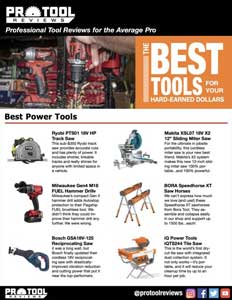After testing dozens of options, our team picked the absolute best cordless reciprocating saw models from manufacturers we trust the most.
What sets these saws apart from the rest of the cordless reciprocating saws? Some run on higher voltages, such as 36V or 60V (54V max). Others use advanced battery technology to pull more power without leaving the 18V/20V max system. However they get there, these saws promise higher performance and some compete with the cutting speeds we see in 15-amp corded reciprocating saws.
We didn’t leave the high-value brands out, though. Whether you’re looking for the most bang for your buck on the professional or DIY level, we have recommendations for you.
While not every saw can be the best, each one of these models earns our stamp of approval.
Best Cordless Reciprocating Saw
Milwaukee M18 Fuel Super Sawzall
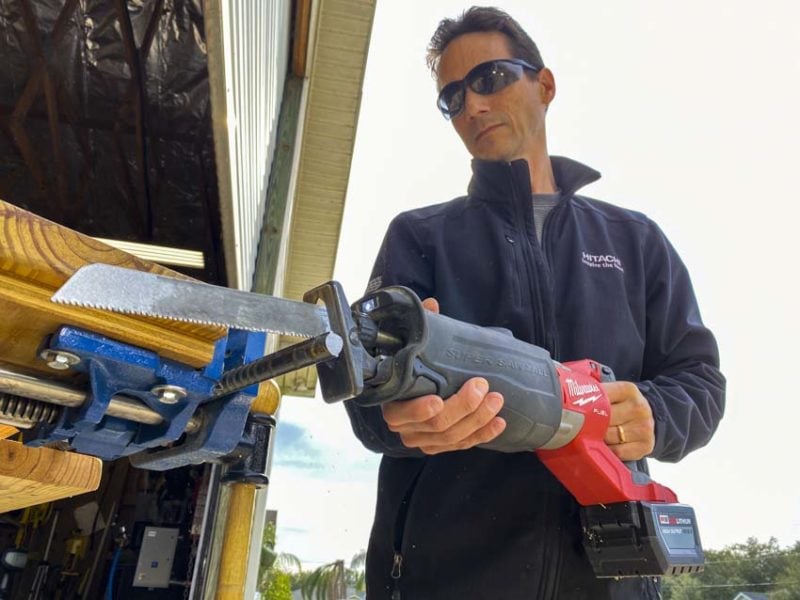
Milwaukee takes the top overall spot for cordless reciprocating saws with cutting speed that leaves its cordless competitors in the dust. Along with its impressive cutting speed, it has an excellent feature set and does a good job of keeping vibration under control. As the inventors of the original Sawzall, Milwaukee builds on its heritage and cutting-edge cordless development to walk away with a well-deserved win.
The downside is that it’s a heavier model. Combined with a 12.0Ah High Output battery, it’s 12.2 pounds. It’s also one of the pricier options available.
Price: $249 bare, $449 kit with 12.0Ah battery and charger
Best Cordless Reciprocating Saw Vibration Control
Metabo HPT 36V MultiVolt Reciprocating Saw
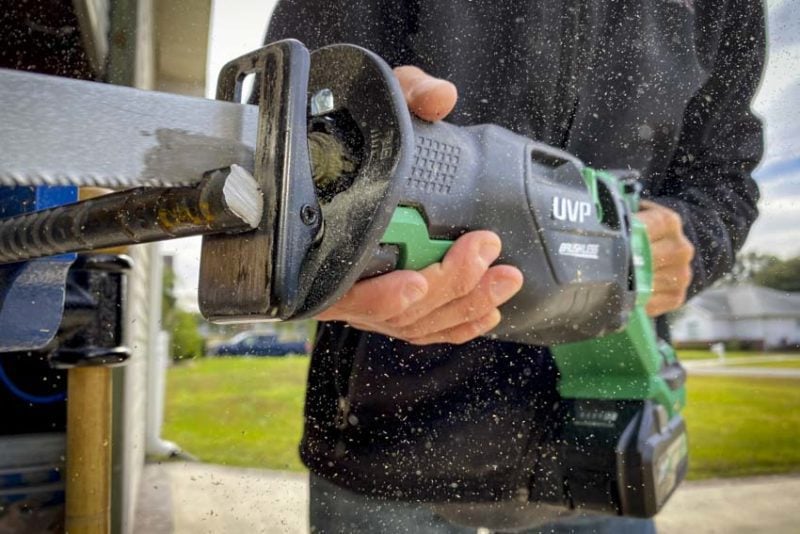
Metabo HPT put together a design for their CR36DAQ4M MultiVolt reciprocating saw that has a clear advantage in vibration control over its competition, making for a more comfortable demolition experience.
While this model doesn’t have the cutting speed of Milwaukee’s M18 Fuel Super Sawzall, it’s 1.5 pounds lighter, has a solid feature set to work with (including an AC adapter if you want to run corded), and has the best ergonomics to go with its low vibration. If comfort is your number one priority, this is the best cordless reciprocating saw for you.
Price: $209 bare
Best Cordless Reciprocating Saw Value
Flex 24V Max Brushless Reciprocating Saw Kit
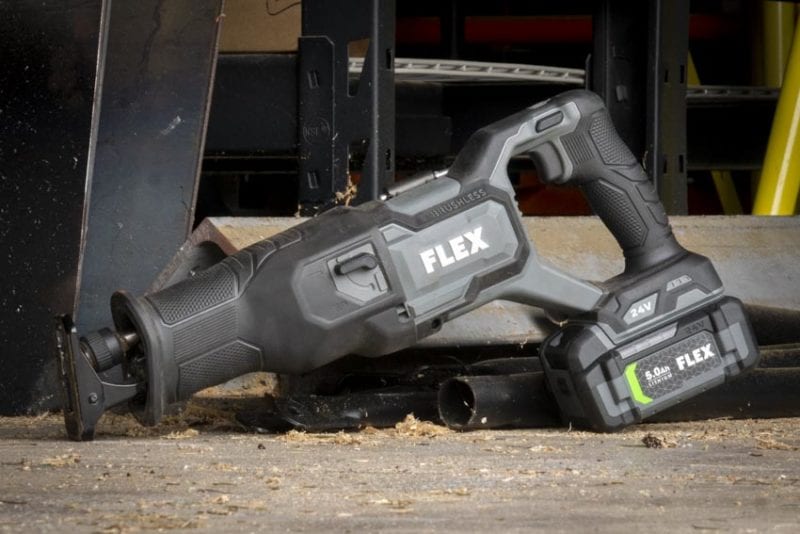
Flex came out of the chute with a well-rounded 24V cordless reciprocating saw designed to replace your 12 or 13-amp corded model using a 1 1/4-inch stroke length and 3000 strokes per minute. The addition of orbital action helps your speed when cutting wood and the rafter hook is certainly welcome.
You don’t get a lever-action blade clamp release or variable speed dial, but that’s easily forgiven when you look at the price tag. With a 5.0Ah battery and fast charger, the kit is just $249 and is backed by a 5-year warranty.
Price: $249 kit with 5.0Ah battery and charger
Best Prosumer Cordless Reciprocating Saw
Ryobi One+ HP Brushless Reciprocating Saw
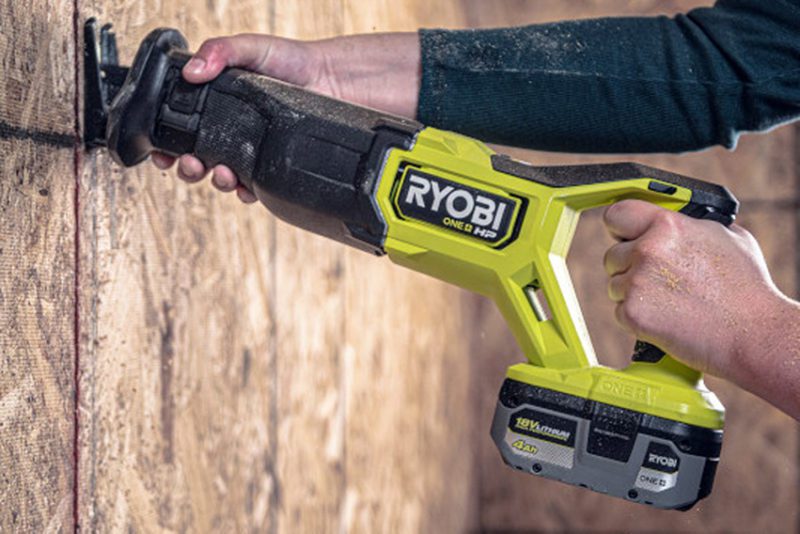
Prosumer is a category that bridges the gap between professional and DIY tools. Meeting the needs of both serious DIYers and budget-minded Pros, the Ryobi One+ HP Brushless reciprocating saw is our top choice in this class. As part of Ryobi’s high-performance cordless line, it’s a step up from previous models, boasting an impressive 3200 SPM and 1 1/4-inch stroke length.
Being a heavily price-conscious category, it’s the cost that makes this model so attractive. The bare tool is $99 and the 4.0Ah High Performance battery kit is just $159. That’s tough to beat.
Price: $99 bare, $159 with 4.0Ah High Performance battery and charger
Best Budget Cordless Reciprocating Saw
Skil PWRCore 20 Compact Reciprocating Saw

Taking our top ranking in the DIY class, check out the Skil PWRCore 20 cordless reciprocating saw. It’s compact and lightweight compared to most saws in this class. With a 1-inch stroke length and 3000 SPM top speed, it cuts slower than higher-priced models but is plenty capable of getting the job done.
The best part is the price—just $89.99 with a 2.0Ah battery and charger.
Price: $89.99 kit with 2.0Ah battery and charger
Best Reciprocating Saw Blades
Lenox Carbide Tipped Reciprocating Saw Blades
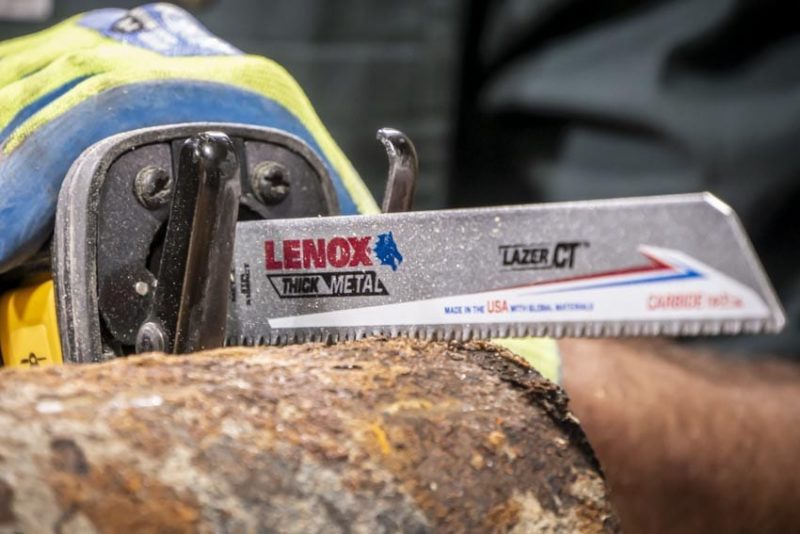
Bi-metal blades are great, but for the longest life and cutting the toughest materials, carbide is king. We used Lenox carbide reciprocating saw blades in our testing and wholeheartedly recommend them at every level. For medium to thick metal, including cast iron, give Lenox Lazer CT blades and shot. For wood demolition that includes nails and screws, take a look at what Lenox Demolition CT blades have to offer.
More Professional Cordless Reciprocating Saw Recommendations
Best Bosch Cordless Reciprocating Saw
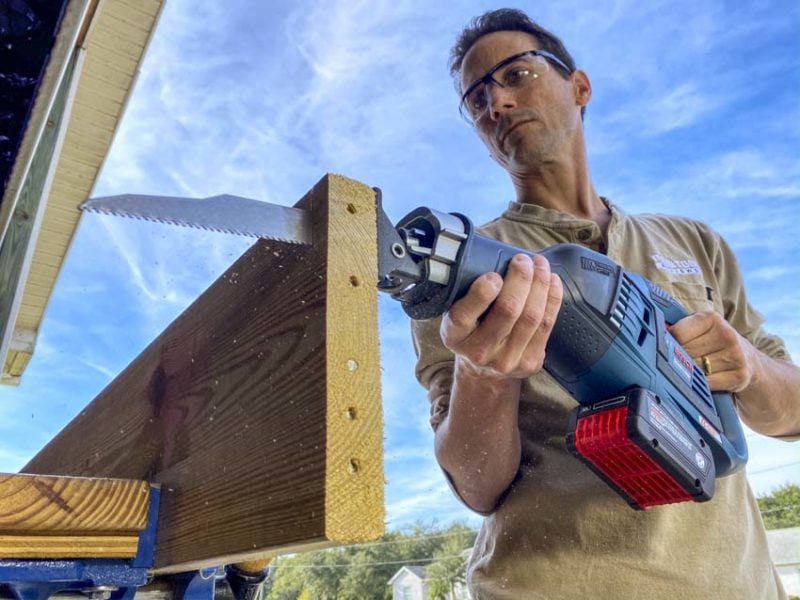
If you’re on the Bosch 18V platform, you have a fantastic reciprocating saw option in the GSA18V-125. Paired with a Core 18V battery, it has a 1 1/4-inch stroke length and cuts faster than its 2500 SPM top speed suggests. It has noticeably improved cutting speed and power with lower vibration than its predecessor, making it a popular demo tool in our shop.
Price: $279 bare, $399 kit with 6.3Ah Core18V battery and charger
Best DeWalt Cordless Reciprocating Saw
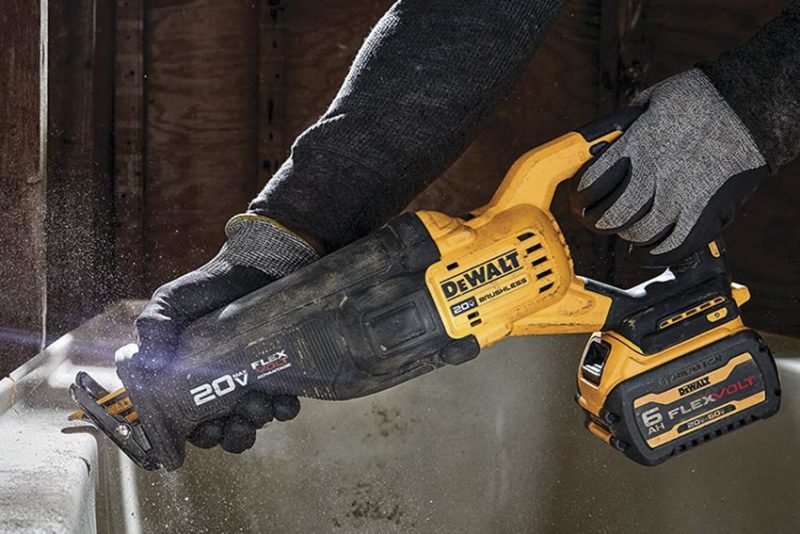
Call us crazy, but our top pick for the best DeWalt reciprocating saw isn’t their second-gen FlexVolt model. Instead, we prefer the DCS386 FlexVolt Advantage reciprocating saw.
Even though it doesn’t quite have the same power level, it’s a more versatile way to work. You can use any DeWalt 20V Max battery to power the saw and keep the weight down. When the cutting gets tougher, switch over to a FlexVolt battery and you gain 50% more power that makes it feel like a completely different tool.
Price: $249 bare
Best Kobalt Cordless Reciprocating Saw
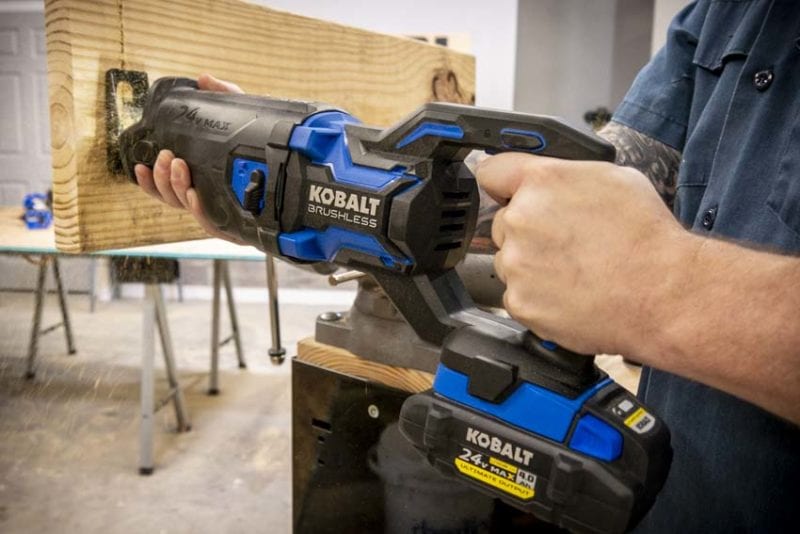
Kobalt’s XTR line marked the high-value brand’s entry into the advanced cordless category that combines battery, motor, and electronics technology to get higher performance from power tools. The Kobalt XTR reciprocating saw has 3100 SPM on the top end and a 1 1/4-inch stroke length. In addition to higher performance, it also introduces an anti-vibration system and selectable orbital action that the previous brushless model didn’t have. Even better, it’s only $20 more, making the upgrade well worth it.
Price: $149 bare
Best Makita Cordless Reciprocating Saw
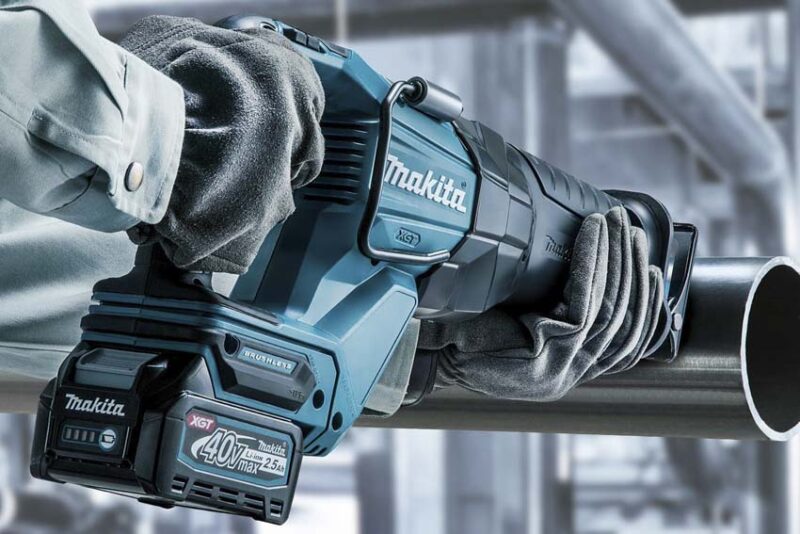
Makita’s GRJ01 kicks off reciprocating saws for the 40V max XGT line. It features two speed settings to cut at 2300 SPM when you need more control and 3000 SPM when you need more speed. Either way, its 1 1/4-inch stroke length removes material quickly.
Similar to the XRJ06 18V X2 model in performance, the XGT model is lighter and sneaks in just under 10 pounds thanks to a single-battery design (9.9 pounds with a 4.0Ah battery).
Price: $239 bare, $389 kit with 4.0Ah battery and rapid charger
Best Ridgid Cordless Reciprocating Saw
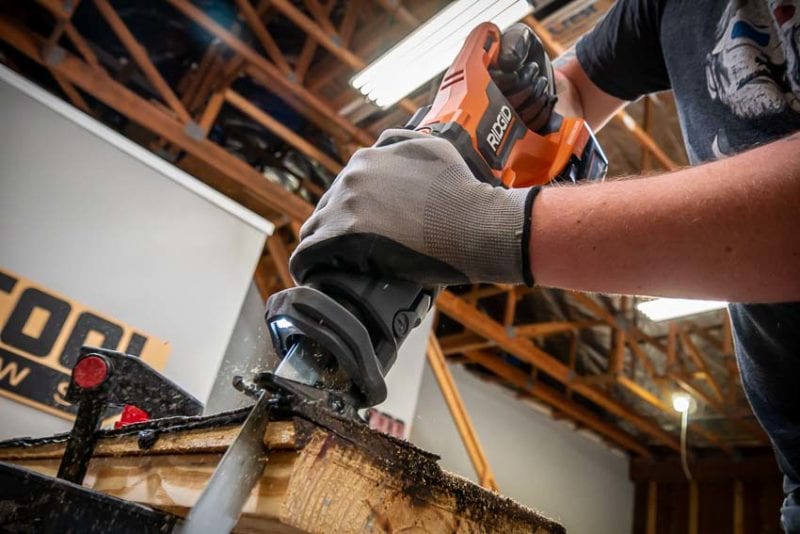
Ridgid has moved on from its Octane line in favor of brushless tools that are lighter and still offer a lot of bang for your buck. The R8647 is nearly half a pound lighter and slightly more compact. At the same time, it picks up speed to hit 3200 SPM and increases to a 1 1/4-inch stroke length.
Price: $159 bare, $199 kit with 4.0Ah Max Output battery and charger, $219 with two 4.0Ah Max Output batteries and charger
More Prosumer Cordless Reciprocating Saw Recommendations
Best Craftsman Cordless Reciprocating Saw
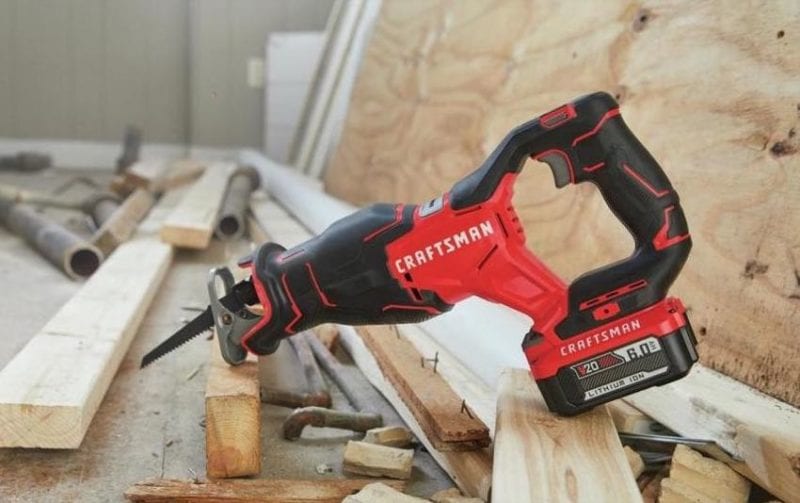
Craftsman’s top cordless reciprocating saw is the CMCS350B. With a brushless motor to improve its performance and runtime compared to the less expensive brushed model, it has a 1 1/8-inch stroke length and 3200 SPM top speed. It’s reasonably lightweight and compact when you look at it side-by-side with some of the top Pro models.
One downside is that it only comes as a bare tool, so you’ll need to add a battery and charger to the price unless you’re already on Craftsman’s V20 system.
Price: $119 bare
Best Skil Cordless Reciprocating Saw
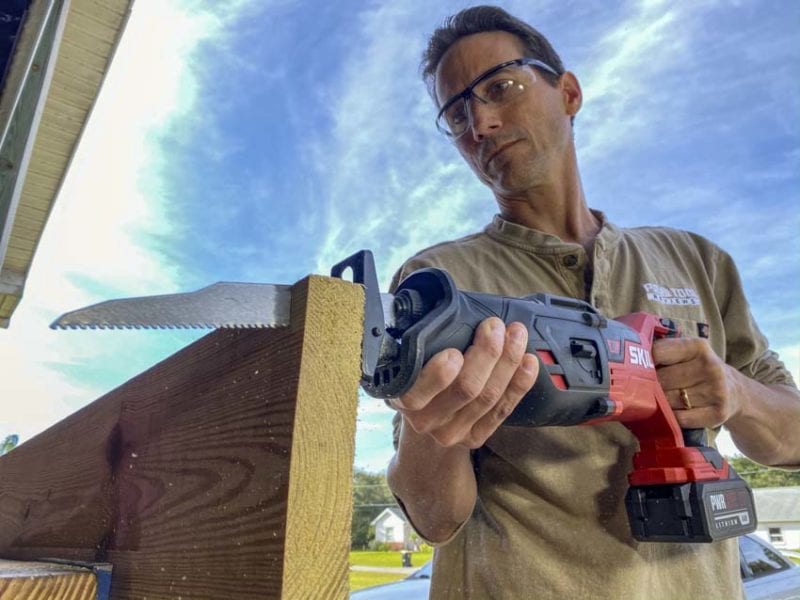
Skil’s PWRCore 20 lineup features two standard cordless reciprocating saws and it’s their brushless RS5884-1A that leads the line in performance. Unlike some saws in this high-value Prosumer class, its 1 1/8-inch stroke rate and 3000 SPM top speed get a boost in wood cutting from a selectable orbital action.
Price: $149 kit with 4.0Ah battery and PWRJump charger
More Budget Cordless Reciprocating Saw Recommendations
Best Hart Cordless Reciprocating Saw
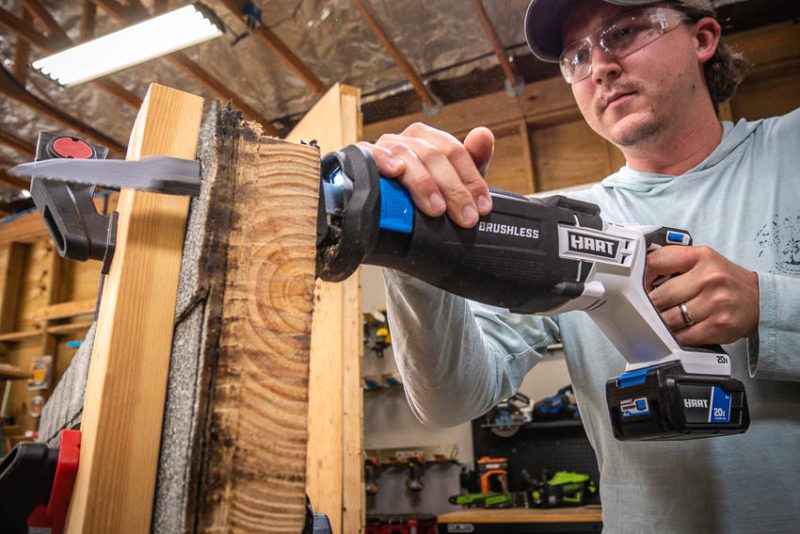
Look no further than your local Walmart for some of the best DIY tools now that Hart has taken over the tool aisles. For well under $150, you get a brushless reciprocating saw with a 1 1/4-inch stroke length and 3200 strokes per minute.
While the price is attractive, it’s for the bare tool and there’s no kit option at the moment. Consider grabbing one of Hart’s combo kits to get started and add the brushless reciprocating saw as a nice upgrade over the brushed model.
Price: $128
Best Cordless Reciprocating Saw Buying Guide | What We Look For
Performance
Whether you’re looking for a top-of-the-line or the best budget cordless reciprocating saw, performance is king. We run a wide range of tests from light-duty PVC and EMT cutting through heavier nail-embedded wood, roofing, rebar, and even cast iron.
At the end of the day, this part of our evaluation is a race. May the fastest cutter win!
Orbital Action
Orbital action introduces an elliptical motion to the blade that is more aggressive and makes wood cutting much faster. Having a selectable orbital mode on your cordless reciprocating saw is a feature you should seriously consider. It’s not an absolute deal-breaker, but try to get one that has it if it’s in your budget.
Vibration Control
Speed is a big part of what we’re looking for, but so is vibration control. Reciprocating saws are rough tools so the more they reduce vibration, the less fatigue you experience. It makes a huge difference and most of our guys are willing to give up a little speed for better vibration control.
Some brands have developed advanced vibration control using counterbalance systems and other technology. While it can add some weight to the tool, they reduce fatigue enough to make the trade-off worth it.
Feature Set
There are a lot of features that make using a cordless reciprocating saw easier, including the orbital action mode we already talked about.
- Brushless Motor: Better performance and runtime, but with a higher price
- Orbital Action: Significantly faster cutting in wood
- Variable Speed Selection: Easier way to manage your speed than feathering the trigger, especially when you’re cutting harder metals
- Smart Controls: App-based customizable controls with the potential for inventory management and tracking
- Blade Clamp Release: Lever-action and slide releases on the housing are much easier than twist releases on the shaft
- Blade Ejection: A spring actively ejects the blade when you release it so you don’t have to grab a hot blade
- Pivoting Shoe: Helps maintain contact with the material on longer cuts or on round material
- Adjustable Shoe: Moves the shoe to engage unused teeth on the blade
- Rafter Hook: Lets you hang the saw on a joist, sawhorse, or ladder when you need to set it down
- LED Light: Lets you see what you’re cutting when there not a lot of light
- Unique Features
Size and Weight
In addition to vibration, weight plays a big part in the fatigue equation. While there’s some correlation between size and weight, it’s not universal. Some full-size saws are pounds lighter than others that have a similar design.
Sometimes the extra weight is due to more metal in the construction and advanced vibration control systems. Other times it’s the need for an advanced or larger battery pack.
While most of the saws in this review are full-size, there are a couple of other classes to consider if you need to get into tight spaces.
Compact cordless reciprocating saws such as Makita’s 18V Sub-Compact are essentially squashed versions of full-size models.
There’s also a group of one-handed reciprocating saws that take an entirely different take on it. The Milwaukee M18 Fuel Hackzall is a good example of those.
Value
At Pro Tool Reviews, value is more than just a list of prices. We take a comprehensive look at what you get for your money such as performance, features, warranty, the number of compatible tools on the same platform.
Why Cordless Reciprocating Saws?
The best cordless reciprocating saw competes well against models in the 15-amp class and can even beat some of the corded ones in cutting performance. Without the cord to trip you up, they can be much more convenient tools to use for demolition work.
Not all of the saws in this review compete on as high a level, though. Some of the lighter models are designed to replace 12-amp saws and are great for overhead and lighter-duty cutting.
The big gap is still in the price—cordless reciprocating saws can cost two or three times their corded counterparts and we don’t expect the price gap to change much in the near future.
Why You Can Trust Pro Tool Reviews
Ever check out a “review” site and you can’t tell if they actually tested anything or if they’re just “recommending” the Amazon top sellers? That’s not us. We won’t recommend anything unless we’d actually use it ourselves, and we don’t really care who the primary retailer is. It’s all about giving you a legitimate recommendation and our honest opinion of each product.
We’ve been in business since 2008 covering tools, writing reviews, and reporting on industry news in the construction and lawn care industries. Our Pro reviewers work in the trades and have the skills and experience to know whether tools can perform well in the field.
Each year, we bring in and review more than 250 individual products. Our team will put our hands on hundreds of additional tools at media events and trade shows throughout the year.
Pro Tool Reviews consults with innovators in the technology and design of tools to gain a broader grasp of where these products fit and how they work.
We work with more than two dozen professional contractors around the United States who review products for us on real job sites. We consult with them extensively on testing methods, categories, and practical applications.
Our site will provide more than 500 pieces of new content this year absolutely free for our readers. That includes objective evaluations of individual tools and products.
The end result is information you can trust because of the editorial, scientific, and real-world professional experience we collectively utilize each and every time we pick up and test a tool.


